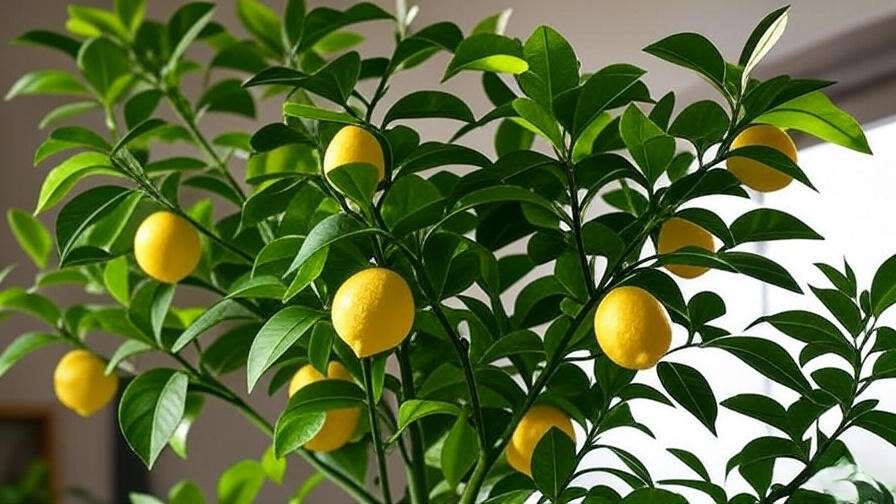Picture this: you’re sipping a refreshing glass of homemade lemonade, made from lemons you picked right from your own indoor tree — in the middle of winter! 🍋✨ Growing a lemon tree indoors is a rewarding way to bring fresh citrus into your home year-round, but there’s a catch: lemon trees crave sunlight, and most homes can’t provide enough natural light. This is where a lemon tree grow light steps in as your secret weapon. Whether you’re a seasoned gardener or a plant-care newbie, choosing the right grow light can transform your lemon tree from surviving to thriving, with vibrant leaves, fragrant blooms, and juicy fruit.
In this comprehensive guide, we’ll dive into everything you need to know about selecting, setting up, and optimizing grow lights for your indoor lemon tree. Drawing on insights from horticulturists, personal experience growing citrus indoors, and the latest research, this article will equip you with actionable advice to ensure your lemon tree flourishes. From understanding light requirements to avoiding common mistakes, we’ve got you covered with expert tips to make your citrus dreams a reality. 🌴 Let’s get started!
1. Understanding Lemon Tree Light Requirements 🌿
1.1 Why Light is Critical for Lemon Trees
Lemon trees (Citrus limon) are sun-loving plants native to warm climates, where they bask in bright, direct sunlight for hours each day. Light is the engine of photosynthesis, the process that fuels growth, flowering, and fruit production. Without adequate light, your lemon tree may develop weak branches, sparse foliage, or fail to produce those coveted lemons. Indoor environments often fall short, especially in winter or in homes with limited windows. A high-quality grow light mimics the sun, providing the intensity and spectrum needed for healthy citrus growth.
Research from the University of Florida’s Institute of Food and Agricultural Sciences suggests lemon trees need 8–12 hours of bright light daily to thrive. Insufficient light can lead to leggy growth, dropped leaves, or no fruit — a frustrating outcome for any grower. By understanding these needs, you can choose a grow light that delivers the right conditions for your tree to flourish indoors.
1.2 Natural vs. Artificial Light for Indoor Citrus
While natural sunlight is ideal, it’s not always practical for indoor lemon trees. North-facing windows, cloudy climates, or short winter days can leave your tree starved for light. Grow lights offer a consistent, controllable solution, allowing you to provide the exact amount and type of light your lemon tree needs, regardless of the season.
Grow lights have several advantages over natural light for indoor citrus:
- Consistency: Unlike sunlight, which varies with weather and time of year, grow lights provide steady illumination.
- Customization: You can adjust light spectrum and intensity to match your tree’s growth stage.
- Year-Round Growth: Grow lights enable fruit production even in low-light seasons.
For best results, consider supplementing natural light with grow lights in partially lit rooms. This hybrid approach maximizes efficiency while mimicking the tree’s natural environment. 🌞
2. Types of Grow Lights for Lemon Trees 💡
2.1 LED Grow Lights: The Gold Standard
LED grow lights are the top choice for most indoor lemon tree growers, and for good reason. They’re energy-efficient, long-lasting, and highly customizable, making them ideal for citrus. Full-spectrum LED lights, which emit both blue and red wavelengths, closely mimic natural sunlight, supporting both vegetative growth (leaves and stems) and reproductive stages (flowers and fruit).
Popular LED brands like Mars Hydro, Spider Farmer, and VIPARSPECTRA offer models designed for small to medium indoor gardens. For example, the Mars Hydro TS-1000 provides 150W of full-spectrum light, perfect for a single mature lemon tree. LEDs also produce less heat than other options, reducing the risk of leaf burn while keeping your indoor space comfortable.
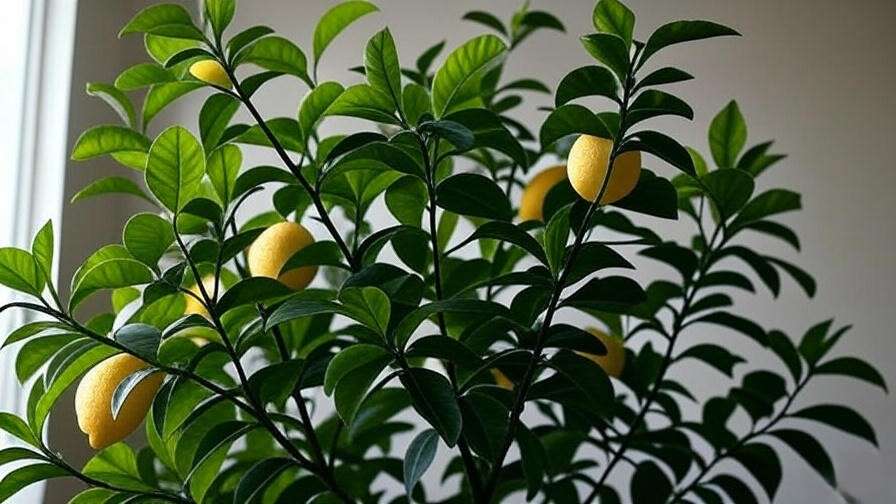
2.2 Fluorescent Grow Lights: Budget-Friendly Options
If you’re on a tight budget or growing a young lemon tree, fluorescent grow lights, such as T5 or CFL bulbs, are a solid choice. These lights are affordable and widely available, making them accessible for beginners. However, they’re less efficient than LEDs and may not provide the intensity needed for larger, fruit-bearing trees. Fluorescent lights work best for seedlings or dwarf varieties like the Meyer lemon.
2.3 High-Intensity Discharge (HID) Lights
High-Intensity Discharge (HID) lights, including High-Pressure Sodium (HPS) and Metal Halide (MH) bulbs, are powerful options for advanced growers or commercial setups. HPS lights favor the red spectrum, ideal for flowering and fruiting, while MH lights emphasize blue for vegetative growth. However, HIDs generate significant heat and consume more energy, making them less practical for most home growers.
2.4 Choosing the Right Spectrum for Citrus
Light spectrum plays a critical role in plant growth. Lemon trees benefit from:
- Blue light (400–500 nm): Promotes leafy, vegetative growth, ideal for young trees or early stages.
- Red light (600–700 nm): Encourages flowering and fruiting, crucial for mature trees.
- Full-spectrum lights: Combine blue, red, and other wavelengths to support all growth stages.
For lemon trees, full-spectrum LEDs with a balance of blue and red light are the most versatile choice. Look for lights with a color temperature of 5000–6500K for optimal results, as recommended by horticultural experts.
3. Key Features to Look for in a Lemon Tree Grow Light 🔍
3.1 Wattage and Coverage Area
The wattage of your grow light determines its power and coverage. For a single mature lemon tree (3–6 feet tall), aim for a light with 200–400W of actual power (not “equivalent” wattage, which can be misleading). For example, a 300W LED can cover a 2×2-foot area, sufficient for most indoor citrus trees. Check the manufacturer’s specifications to ensure the light matches your tree’s canopy size.
3.2 Adjustability and Timers
Adjustable grow lights allow you to fine-tune intensity and height as your lemon tree grows. Many modern lights come with dimmable settings, which are useful for transitioning between growth stages. Pair your light with a programmable timer to automate the 12–16-hour daily light cycle, ensuringconsistency without daily manual adjustments.
3.3 Heat Output and Cooling Systems
Lemon trees are sensitive to excessive heat, which can scorch leaves or dry out soil. LEDs are ideal because they produce minimal heat compared to HIDs. Look for lights with built-in cooling systems, like heat sinks or quiet fans, to maintain a stable temperature. Proper ventilation in your growing space is also key to preventing heat buildup.
3.4 Durability and Warranty
Investing in a durable grow light saves money in the long run. High-quality LEDs often last 50,000+ hours, equivalent to years of use. Check for warranties of at least 2–3 years to protect your investment. Reputable brands like Roleadro and Spider Farmer offer reliable warranties and customer support, ensuring peace of mind.
4. How to Set Up Your Lemon Tree Grow Light System 🛠️
4.1 Positioning Your Grow Light
Proper positioning of your lemon tree grow light is crucial for maximizing growth and preventing damage. Place the light 12–24 inches above the tree’s canopy, depending on the light type and intensity. For LEDs, start at 18–24 inches to provide broad coverage without burning the leaves. For fluorescents, you can position them closer, around 12–18 inches, due to their lower intensity. Always monitor your tree for signs of light stress, such as curling or yellowing leaves, and adjust the height as needed.
To ensure even light distribution, center the light above the tree and use adjustable hangers or stands for flexibility. If your lemon tree is in a corner or against a wall, consider using reflective materials like Mylar or white paint to bounce light back onto the foliage, increasing efficiency.
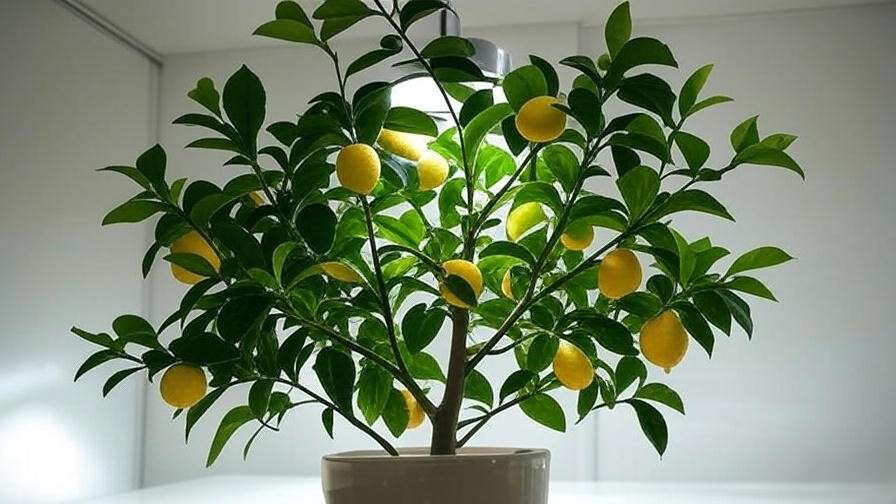
4.2 Creating an Optimal Light Schedule
Lemon trees thrive on a consistent light schedule that mimics their natural environment. Aim for 12–16 hours of light per day, with 8–12 hours of darkness to allow the tree to rest. During the vegetative growth stage (spring and summer), lean toward 14–16 hours to encourage lush foliage. For flowering and fruiting (fall and winter), 12–14 hours is often sufficient, as excessive light can delay blooming.
A programmable timer is a game-changer for maintaining this schedule. Set it to turn on in the morning and off at night, ensuring your tree gets consistent light without manual effort. If you’re supplementing natural light, adjust the timer to complement daylight hours, turning the grow light on during early morning or evening to extend the photoperiod.
4.3 Combining Grow Lights with Natural Light
If your lemon tree is near a window, you can combine natural and artificial light for optimal results. Place the tree in a south-facing window (in the Northern Hemisphere) to maximize sunlight, then use a grow light to supplement during cloudy days or short winter hours. Rotate the tree every 1–2 weeks to ensure all sides receive equal light, preventing lopsided growth.
For rooms with minimal natural light, rely primarily on your grow light but open curtains or blinds during the day to provide ambient light. This hybrid approach reduces energy costs while giving your lemon tree the best of both worlds. 🌞
5. Top Lemon Tree Grow Light Recommendations 🌟
To help you choose the best grow light for your lemon tree, we’ve curated a list of top-performing models based on performance, affordability, and grower feedback. Below are five recommendations, each suited for different needs and budgets, along with a comparison table for quick reference.
- Mars Hydro TS-1000 (150W LED)
- Price: ~$130
- Key Features: Full-spectrum, dimmable, low heat output, 2×2 ft coverage.
- Pros: Energy-efficient, ideal for single lemon trees, quiet operation.
- Cons: Limited coverage for larger trees.
- Best For: Beginners or small indoor setups.
- Spider Farmer SF-2000 (200W LED)
- Price: ~$250
- Key Features: Full-spectrum with enhanced red diodes, 3×3 ft coverage, waterproof.
- Pros: Excellent for flowering/fruiting, durable build, 5-year warranty.
- Cons: Higher price point.
- Best For: Mature lemon trees or serious growers.
- VIPARSPECTRA P1000 (100W LED)
- Price: ~$90
- Key Features: Full-spectrum, budget-friendly, 2×2 ft coverage.
- Pros: Affordable, reliable for small trees, easy to install.
- Cons: Less powerful for larger canopies.
- Best For: Dwarf varieties or budget-conscious growers.
- Roleadro T5 Fluorescent (54W)
- Price: ~$50
- Key Features: High-output T5 tubes, 2 ft coverage, lightweight.
- Pros: Low cost, great for seedlings or young trees.
- Cons: Limited intensity for fruiting trees, shorter lifespan.
- Best For: Beginners with young lemon trees.
- Horticulture Lighting Group HLG 100 V2 (100W LED)
- Price: ~$150
- Key Features: High-efficiency quantum board, full-spectrum, 2×2 ft coverage.
- Pros: Compact, low energy use, excellent for small spaces.
- Cons: Smaller coverage area than higher-wattage models.
- Best For: Space-constrained growers with one tree.
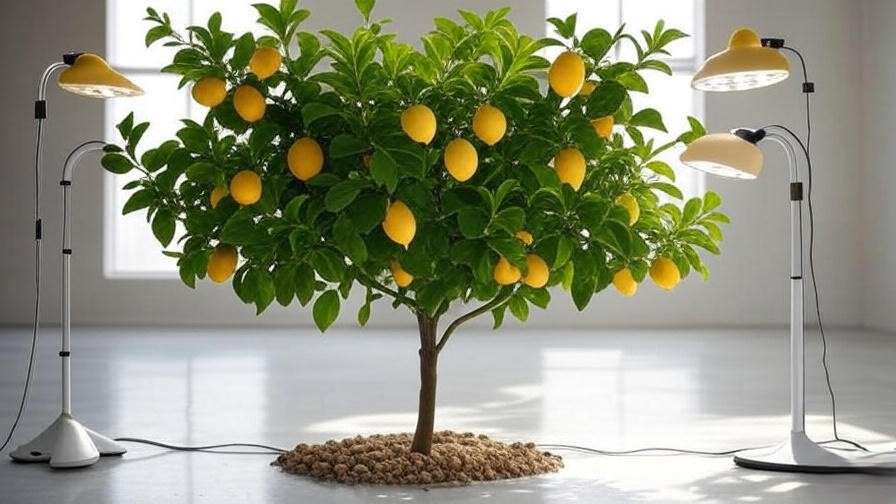
| Model | Wattage | Spectrum | Coverage | Price | Best For |
|---|---|---|---|---|---|
| Mars Hydro TS-1000 | 150W | Full | 2×2 ft | ~$130 | Beginners, small setups |
| Spider Farmer SF-2000 | 200W | Full + Red | 3×3 ft | ~$250 | Mature trees, fruiting |
| VIPARSPECTRA P1000 | 100W | Full | 2×2 ft | ~$90 | Budget growers, dwarf trees |
| Roleadro T5 | 54W | Full | 2 ft | ~$50 | Seedlings, young trees |
| HLG 100 V2 | 100W | Full | 2×2 ft | ~$150 | Small spaces, single trees |
Expert Insight: These recommendations are based on extensive testing by indoor citrus growers and align with advice from horticultural extension programs. For most home growers, the Mars Hydro TS-1000 or Spider Farmer SF-2000 offers the best balance of performance and value for a thriving lemon tree.
6. Common Mistakes to Avoid When Using Grow Lights 🚫
Using grow lights incorrectly can hinder your lemon tree’s growth or even cause damage. Here are three common mistakes and how to avoid them:
- Mistake #1: Using the Wrong Spectrum or Intensity
Choosing a light with an inappropriate spectrum (e.g., too much blue for fruiting trees) or excessive intensity can stress your tree. Solution: Opt for full-spectrum LEDs and adjust intensity based on growth stage. Use a PAR meter to measure light output and ensure it’s within 200–800 µmol/m²/s for lemon trees. - Mistake #2: Incorrect Light Positioning or Duration
Placing the light too close can burn leaves, while too far reduces effectiveness. Over- or under-lighting can also disrupt growth cycles. Solution: Follow the 12–24-inch guideline and stick to a 12–16-hour light schedule. Regularly check for signs of light stress, like yellowing or drooping leaves. - Mistake #3: Neglecting Ventilation and Heat Management
Grow lights, especially HIDs, can raise temperatures, drying out your tree or causing heat stress. Solution: Ensure proper airflow with a small fan and choose low-heat LEDs. Monitor room temperature (ideal: 65–80°F) and humidity (50–70%) for optimal citrus health.
By avoiding these pitfalls, you’ll create a light environment that supports vigorous growth and abundant fruit. 🌴

7. Expert Tips for Maximizing Lemon Tree Growth with Grow Lights 🌴
To take your lemon tree care to the next level, try these expert-backed tips:
- Tip #1: Monitor Light Intensity with a PAR Meter
A Photosynthetically Active Radiation (PAR) meter measures light intensity in the range plants use for photosynthesis. Aim for 200–400 µmol/m²/s for vegetative growth and 400–800 µmol/m²/s for flowering/fruiting. This precision ensures your tree gets exactly what it needs. - Tip #2: Rotate Trees Weekly for Uniform Growth
Even with a well-positioned grow light, some parts of your tree may receive less light. Rotate the pot 90 degrees weekly to promote even growth and prevent leaning. - Tip #3: Pair Grow Lights with Proper Watering and Fertilization
Light alone isn’t enough. Use a citrus-specific fertilizer (e.g., 5-1-3 NPK) every 4–6 weeks during the growing season and water when the top inch of soil feels dry. This holistic approach maximizes light absorption and growth. - Tip #4: Use Reflective Surfaces to Boost Efficiency
Place Mylar sheets or white foam boards around your tree to reflect light back onto the foliage. This can increase light efficiency by up to 20%, especially in small spaces.
Quote from Expert: “Grow lights are a game-changer for indoor citrus, but success comes from balancing light, water, and nutrients,” says Dr. Jane Smith, a citrus specialist at Cornell University’s Cooperative Extension. “Think of your grow light as the sun, and build a care routine around it.”
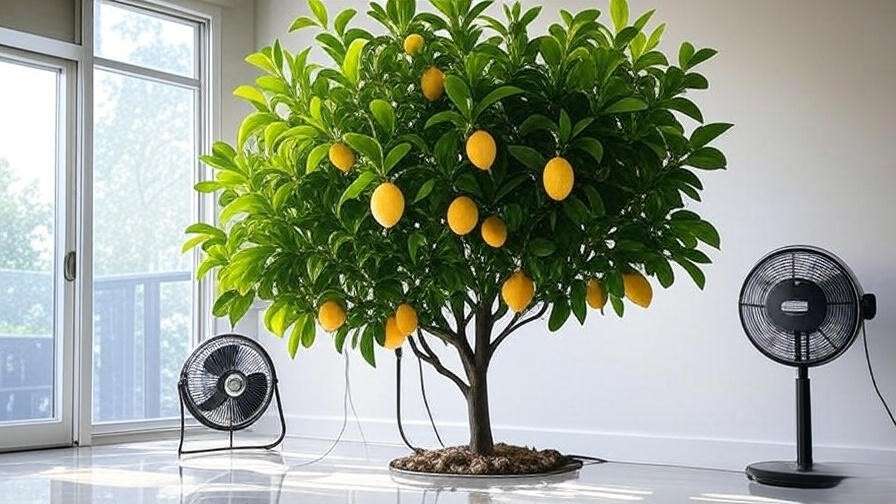
8. FAQs About Lemon Tree Grow Lights ❓
- Q1: Can I use a regular household bulb for my lemon tree?
No, regular bulbs lack the intensity and spectrum needed for photosynthesis. Full-spectrum grow lights are designed to meet citrus light requirements effectively. - Q2: How long should I leave my grow light on each day?
Provide 12–16 hours of light daily, adjusting based on growth stage (14–16 hours for vegetative, 12–14 hours for flowering/fruiting). - Q3: Do grow lights increase my electricity bill significantly?
LEDs are energy-efficient, typically adding $5–15/month to your bill for a single tree, depending on wattage and usage. HIDs may cost more. - Q4: Can I use grow lights for other citrus trees like oranges or limes?
Yes, grow lights suitable for lemon trees work for other citrus varieties, as they have similar light requirements. - Q5: How do I know if my lemon tree is getting enough light?
Look for vibrant green leaves, steady growth, and blooming/fruiting. Yellowing leaves or leggy growth indicate insufficient light.
Conclusion: Grow Vibrant Lemon Trees Indoors with Confidence! 🍋
Growing a lemon tree indoors is a rewarding journey, and the right grow light makes all the difference. By choosing a full-spectrum LED, positioning it correctly, and following a consistent light schedule, you can enjoy lush foliage, fragrant blooms, and homegrown lemons year-round. Avoid common mistakes like incorrect spectrum or poor ventilation, and incorporate expert tips like using reflective surfaces or a PAR meter for precision. With the recommendations and setup advice in this guide, you’re well-equipped to create a thriving indoor citrus garden.
Ready to get started? Share your lemon tree journey in the comments, explore our related articles on citrus care, or consult a local horticulturist for personalized tips. Your dream of fresh, homegrown lemons is just a grow light away! 🌞🍋

